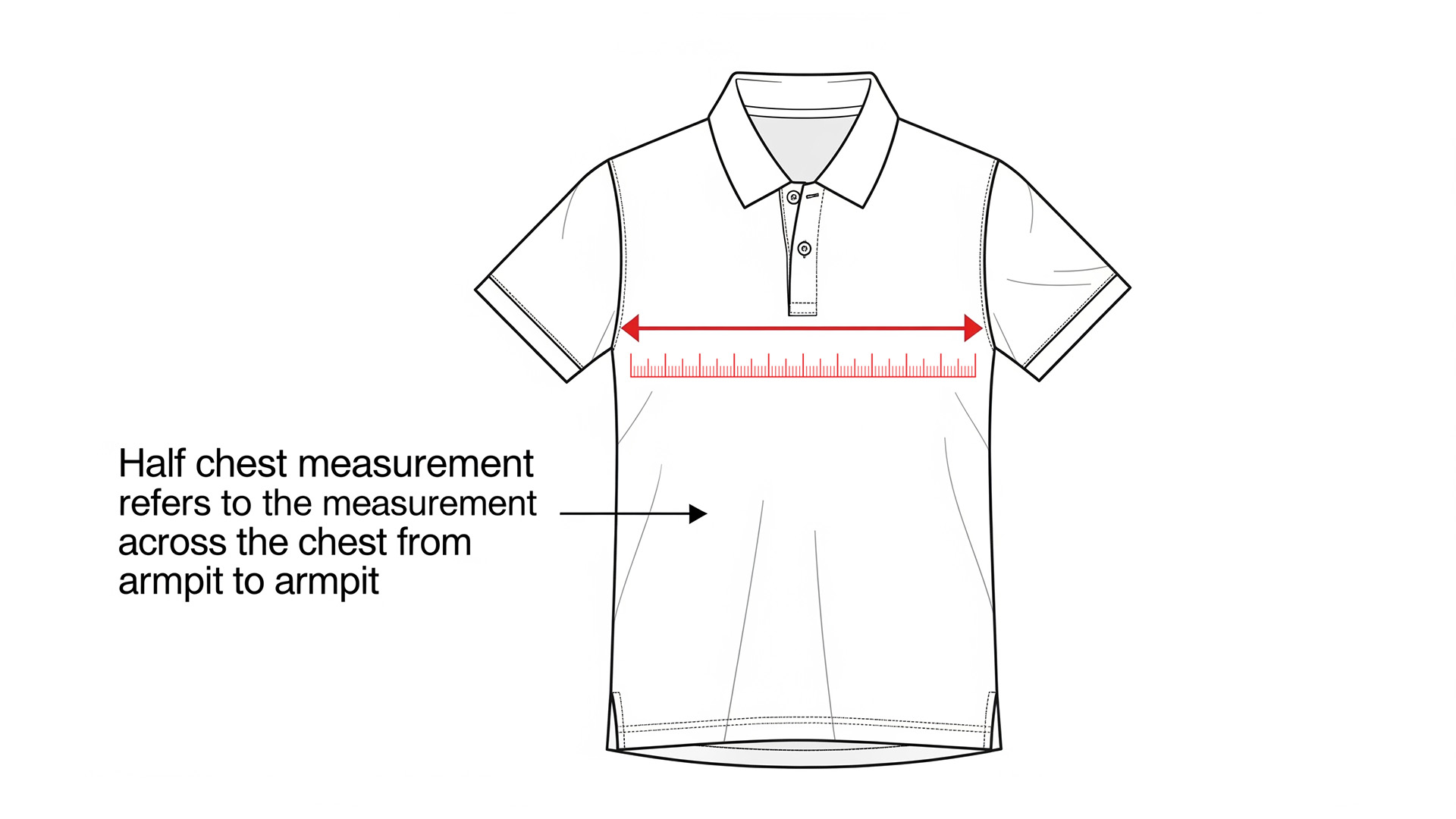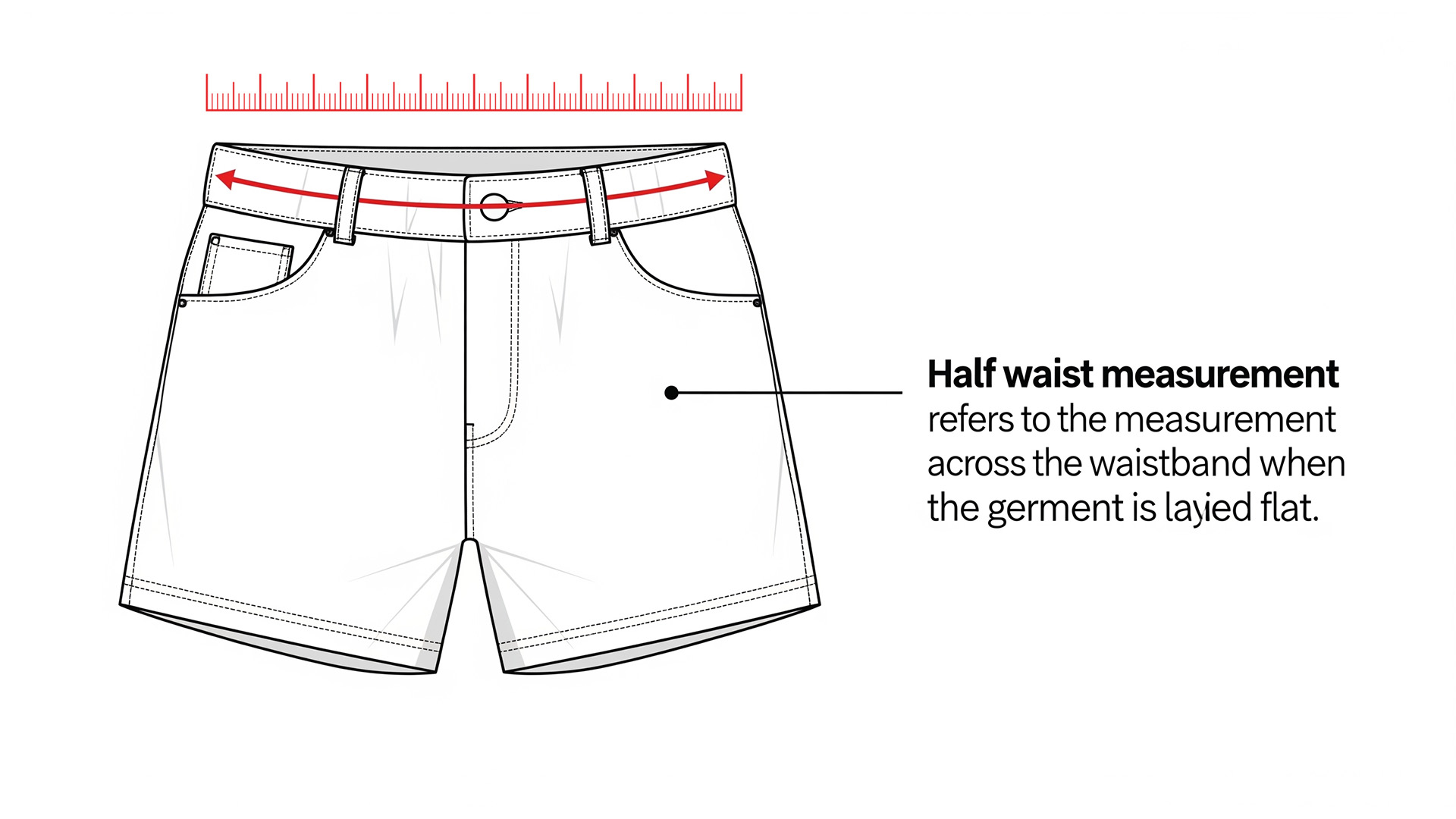Measuring Instuctions (Guide Only)
This guide explains the different terms used in garment size guides and shows you how to take your own measurements when choosing your fit.
Please Note: This is a general guide only, please refer to specific sizing instructions for your desired garment in the product descriptions section or style sheet.
If you would like to share feedback about this page, please contact us directly via the link below: Ask us about sizing
Tops
T-Shirts, Shirts, Blouses, Sweaters/Jumpers, Hoodies, Cardigans, Polos, Tunics, Crop Tops, Tank Tops/Singlets, Camisoles, Vests, Tube Tops, Bodysuits, Activewear Tops
How to Measure Half Chest (Garment Measurement) for tops
The "half chest" measurement is taken directly from the garment itself, not your body. It's a key indicator of how wide a top will be. A top's "half chest" measurement is taken when laid on a flat surface and measured arm pit to arm pit.
What you'll need:
- A top you want to measure (e.g., a t-shirt, shirt, or jumper)
- A measuring tape (cloth or flexible metal)
- A flat surface (e.g., a table or clean floor)
Instructions:
-
Lay the Garment Flat:
- Place the top flat on a clean, hard, and even surface.
- Smooth out any wrinkles or creases, ensuring the front and back layers are perfectly aligned and not bunched up.
-
Locate the Armpit Seams:
- Identify where the sleeve seam meets the main body of the top, directly under the armpit. These are your starting and ending points.
-
Measure Across:
- Take your measuring tape.
- Place one end of the tape precisely at the point where the armpit seam starts on one side of the top.
- Stretch the tape straight across the front of the top, ensuring it remains flat and horizontal.
- Read the measurement at the point where the armpit seam starts on the opposite side.
-
Record the Measurement:
- This figure is your "half chest" measurement.
Half Chest Measurement Diagram

Lowers
Trousers, Pants, Jeans, Shorts, Skirts, Leggings, Jeggings, Capris, Culottes, Track Pants, Cargo Pants, Chinos, Boardshorts, Swim Shorts.
What's a Half Waist Measurement?
Put simply, a half waist measurement is half the circumference of your waist. Instead of measuring all the way around, you're measuring from one side of the waist to the other when the garment is laid flat.
How to Take a Half Waist Measurement (Step-by-Step)
You'll take this measurement on a garment, not on a person. Here's how you do it:
What you'll need:
- A flat surface (a table or clean floor works a treat)
- A measuring tape (cloth or flexible metal)
Steps:
- Grab your Garment: Lay the garment you want to measure (trousers, skirt, shorts, etc.) flat on your clean, smooth surface.
- Smooth it Out: Make sure there are no wrinkles, puckers, or folds in the waistband. You want it as flat and even as possible, just like it would sit when worn.
- Locate the Waistband: Identify the top edge of the waistband. This is the part that would sit around your natural waist or where the garment is designed to sit on your body.
- Align Your Tape: Place one end of your fabric measuring tape at one side of the waistband, right at the outer edge. Make sure it's snug against the fabric but not stretching it.
- Measure Across: Run the measuring tape straight across the very top edge of the waistband to the opposite outer edge.
- Read the Measurement: Take your reading. That's your half waist measurement!
Half Waist Measurement Diagram

Description
Please Note: These pants are not suitable for laborious work conditions that require a high range of movement or durability. If you are looking for durable, weather resistant work pants, please view the products via the links provided below:
 |  |
3703 - PVC Rain Pants
For Complete Sizing Guide, Click Here
Fabric
- PVC Material
Details
- Elastic waist and adjustable studs on leg cuff.
- This does not comply with AUS /NZ HiVis Standard.
Measurements

Features
- SUN Protection UPF 40+ - 50+
- DNC garments are tested for UPF (ultraviolet protection factor) in accordance with AS/NZS4399:1996. The level of protection varies depending on the fabric and colour of the garment. 15+ good protection, 30+ / 35+ very good protection, 40+ / 50+ excellent protection.
- Environmentally Friendly Green Dye Oeko-Tex Standard 100 Safe to wear against the skin
- All DNC garments use the Green Dye only, except for the Patrol Saint Flame Retardant range. All DNC garment fabric fully complies with Oeko-Tex standard 100 class II for products with direct contact to the skin in which prohibited to use aromatic amines, sensitizing dyes and cancer risk dyes. Green dye should meet the following conditions: Does not contain harmful or non-aromatic amine; dye itself, noncarcinogenic, sensitization, acute toxicity; the use of formaldehyde and, after extraction of heavy metals in the following limits; non-environmental hormone; non persistent organic pollutants; does not produce pollution of the environment harmful chemicals; not produce chemicals that pollute the environment; colour fastness and superior to disable the use of dyes.
- Waterproof
- DNC Rainwear and HiVis Jackets are made of a polyester outer, PU coated inner and all seam sealed 100% waterproof.
Additional Information
Features: |
Waterproof |
Style: |
Pants |
Safety Class: |
Day/Night |
Promotion: |
Spend & Save |
Features: |
Seam-sealed |
Features: |
Elastic Waist |
1 Review
-
great value
pvc is thick and sturdy, has thread mesh on the inside. a size chart would help but i found one at www.dncworkwear.com.au










